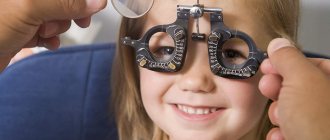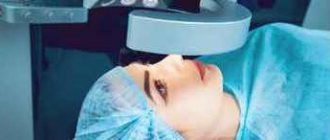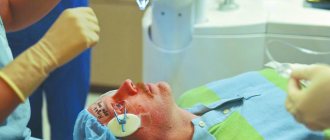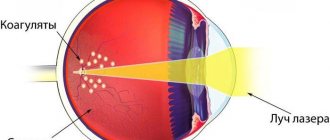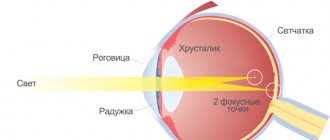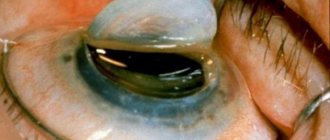Radial keratotomy is a microsurgical operation aimed at correcting refractive error. It was performed on patients with myopia, astigmatism, keratoconus, as well as pathologies of the cornea structure. Due to the serious consequences of the operation and the inability to predict the result, the method is currently not used.
Surgery is performed under local anesthesia. At the first stage, the surgeon marks the locations of future radial incisions of the cornea, and then models them with a diamond knife. Under the influence of intraocular pressure, the configuration of the cornea changes slightly, which is why its refractive ability also changes. As a result, visual dysfunction is corrected. Complications of radial keratotomy include: the occurrence of hypermetropia, secondary astigmatism, thinning or perforation of the cornea.
A little about the method
Radial keratotomy, or more precisely, anterior dosed radial keratotomy, is a method introduced into clinical practice in 1977. The technology was proposed by the Soviet ophthalmologist Academician S. N. Fedorov. Among its advantages are ease of implementation and sufficient effectiveness. Radial keratotomy does not require expensive equipment and is considered a routine method. A modification of her traditional technique made it possible to use the method to treat patients with keratoconus. With the advent of excimer lasers in ophthalmology, radial keratotomy is practically not used.
A modern analogue of this operation is photorefractive keratectomy (PRK). It is based on ablation of the superficial corneal layer using an excimer laser. This method is more accurate, however, in comparison with radial keratotomy, the postoperative period of PRK is much more often complicated by corneal opacification. In addition, restoration of visual functions after surgery takes quite a long time.
The performance of radial keratotomy today is explained by the presence in some patients of contraindications to performing LASIK laser procedures and its modifications.
Recovery
For several days (less often weeks) after keratotomy, vision may be blurred, but this will not interfere with normal life. The patient must refrain from driving until visual function is completely restored. In the first 3 months, instability of eye acuity may appear, which will also change slightly during the day. To prevent the addition of a bacterial infection, a course of antibiotics is prescribed during the rehabilitation period. Non-steroidal anti-inflammatory drugs will help eliminate pain and relieve swelling.
Contraindications
Performing radial keratotomy is not advisable for progressive myopia. In addition, inflammatory eye diseases (including those of an infectious nature) in the decompensation stage are limitations. Malignant neoplasms inside the orbit are an absolute contraindication to surgery. Corneal dystrophies seriously complicate the surgical technique; in addition, they are associated with a high risk of corneal perforation. Due to the risk of secondary infection, radial keratotomy is also not performed in patients with dermatitis.
Progress of the operation
When performing radial keratotomy, local anesthesia is used. At the first stage of the operation, the surgeon marks the central optical zone and the center of the pupil. Then the projection area of the radial cuts is marked. Next, the thickness of the cornea is measured and the knife is adjusted using a micrometer. Under the control of a microscope, a special diamond knife is calibrated along its entire length. Before making incisions, fluid from the surface of the cornea is carefully removed.
The radial incisions made by the surgeon during the operation penetrate the cornea to 9/10 of its thickness. After their application, the wound surface is cleaned. After the incisions, the peripheral parts of the cornea protrude somewhat outward, while its central part is somewhat flattened. Such changes occur under the influence of intraocular pressure. The center of the cornea with a diameter of 3.2-4 mm (optical zone) remains intact.
To treat keratoconus, an adapted radial keratotomy is used, when incisions are made asymmetrically in the central part of the cornea.
Keratotomy
Most people suffer from reduced vision function.
This interferes with life; you have to use contact lenses or glasses to see well.
There is surgery to correct the cornea (keratotomy), with which you can completely restore vision function up to 100%. The type of operation is selected by the doctor individually for each patient after conducting diagnostic tests.
Rehabilitation and recovery
After surgery, rehabilitation is long. For laser treatment this time is significantly reduced. The patient must comply with the following rules:
- wear sunglasses outside;
- take medications prescribed by a doctor;
- do not visit the sauna, bathhouse, bathing in hot water is prohibited;
- Do not sunbathe in the open sun for 1 month;
- It is forbidden to touch your eyes with your hands or apply makeup;
- It is recommended to completely avoid situations where eye injury may occur;
- It is recommended to reduce the amount of time spent watching TV, computer, and reading books.
After the operation, it is recommended to visit the doctor three times at the time prescribed by him. If no complications arise, the rehabilitation period after surgery lasts for 2 months. If there was a laser procedure, the period is reduced to 2 weeks.
Forecast
If the patient has chosen the right medical facility and surgeon, the prognosis for his condition will be positive. The most dangerous complication is decreased visual acuity. It will not lead to the death of the patient, but can significantly worsen his quality of life.
Was the article helpful?
Source: https://proglazki.ru/operatsii/keratotomiya/
Keratotomy is the essence of the vision correction method
Keratotomy is a microsurgical operation of the eye aimed at restoring the proper functioning of the visual apparatus. Read about lens replacement surgery for astigmatism here.
The operation is performed using two methods: laser and surgical, both methods are safe.
In general, the operation takes no more than 3 hours. Keratotomy allows you to get rid of diseases such as myopia, farsightedness and astigmatism.
The doctor makes small incisions on the cornea, which correct its curvature, thus restoring full focusing of the visual apparatus. To carry out the procedure, a special diamond blade is required.
Read about the treatment of myopia in school-age children here.
We should not forget that even surgical intervention does not provide full guarantees and a 100% result, so not many patients agree to surgery, because they believe that if ideal vision does not return, then surgery is useless.
Indications and contraindications
Like any procedure, keratotomy has its own indications and contraindications. Contraindications include:
- pregnancy;
- age under 18 and over 45 years;
- thinned cornea;
- diabetes;
- breast-feeding;
- mental disorders;
- progressive myopia;
- inflammatory processes in the eyes;
- glaucoma;
- skin dermatitis.
Indications: mild myopia.
The operation is not recommended for children under 18 years of age, but if the patient has undergone a full diagnosis, passed all the necessary tests, and the results have revealed that the operation will not harm the child’s body, then the procedure is possible.
Types of eye surgeries
There are two types of keratotomy: laser and refractive, both types are quite effective. Most patients are inclined to laser vision correction, since it does not require the use of scalpels and the healing process is noticeably faster. This material will tell you about Indian eye drops Ujala.
In addition, the use of a laser makes it possible to limit the area of tissue damage.
It penetrates only into the cornea of the eye, without affecting other components of the eyeball.
Refractive keratotomy is a more dangerous procedure, as it is performed with a special diamond scalpel, which is used to make incisions on the cornea, restoring its correct position. Read about the treatment of progressive myopia in children and adults at this link.
Is vision corrected after a laser procedure?
The laser correction method is a microsurgical eye operation. Using this method, the natural shape of the cornea changes, thereby eliminating the light-refractive anomaly of the eyes.
There are several positive qualities of this procedure:
- General anesthesia is not administered to the human body. The operation requires local anesthesia in the form of eye drops.
- The procedure does not require a long hospitalization; you can go home the same evening.
- During the procedure, the laser acts only on the cornea, without affecting other parts of the eye.
- The entire procedure takes 2 hours. It is worth noting that at first the operation is performed only on one eye, and if it is successful and vision is restored, then the operation can be performed on the second eye.
Rehabilitation period and care
The recovery period after the procedure is quite short. After the operation, you can return home in the evening of the same day. First, the doctor applies a special bandage to the patient’s eye or suggests using a protective lens to prevent pain. An analgesic may also be prescribed and will need to be taken for 2-4 days after surgery.
The day after the procedure, the patient must visit the ophthalmologist's office to check how the healing process is going, as well as to prescribe special anti-inflammatory drops.
The procedure will not give immediate results; vision will be restored gradually over several weeks.
Vision may be blurry and blurry, but this is completely normal.
For a month and a half after the procedure, the patient should stop driving, as viewing road signs will be very problematic.
Doctors also note that from 2 months to a year there may be a change in vision during the day, that is, in the morning it will be very clear, but not at night, or vice versa.
A few rules that must be followed:
- Do not lean forward for the first 7 days after surgery.
- You need to sleep on your back or on the side opposite the operated eye if the operation was only on one eye.
- Avoid visiting baths and saunas for a month.
- Refuse to go to the gym, lift weights and other work that requires heavy loads.
It is very important to follow all the rules after surgery so that no adverse reactions occur that will lead to the return of the disease or even further progression.
Treatment outcome and side effects - late complications and consequences
The main result of the operation is the restoration of vision, but it is worth noting that the patient before the procedure must understand and accept the fact that vision may not return one hundred percent, for example, if a person’s vision is minus 6, then after the operation it may become minus 1-1 .5 dioptres. This is a normal result, so there is no need to worry about it.
Incomplete correction of myopia can lead to the development of farsightedness.
Also, vision can be restored to 100 percent, but after a few years, vision deterioration will begin again. There are also cases where vision was restored to 100 percent, but within 10 years the patients developed farsightedness, which they did not even notice.
Do not forget that every operation has its own side reactions and late complications, for example, after the operation, vision is not corrected, so you should not be afraid to lie down on the operating table and think about what will happen next.
This video will tell you in detail about radial keratotomy.
Conclusion
In conclusion, I would like to say that even hardware treatment and surgery do not give a 100% result, and sometimes eye microsurgery can even lead to various harmful consequences. But patients should not forget that the result depends on the stage of advanced myopia, on the abilities of the doctor performing the operation, on compliance with standards and indications after the procedure.
Keratotomy of the eye is a very effective procedure, so in 95% of cases, the patient’s vision returns and he becomes a full-fledged person again. The operation is quite expensive, approximately 60 thousand rubles, so not many will be able to afford this procedure, but a person’s health, and especially his eyes, is many times more expensive than money.
Source: https://OkulistPro.com/bolezni/ametropii/blizorukost/lechenie-blizorukost/operatsii/keratotomiya.html
Risks and complications
The most common complication of radial keratotomy is the development of reverse astigmatism. In addition, fibroplasia of postoperative scars can cause discomfort in the eyes or pathologies of refraction. Performing a radial keratotomy can also provoke a hypermetropic shift, which occurs due to the formation of holes in the cornea due to the excessive number, great depth and length of the incisions made. For patients with radial keratotomy, if age-related cataracts occur in the future, it may be difficult to select an intraocular lens.
Another complication of surgical intervention is a decrease in the density of corneal endothelial cells, which can cause its thinning. Degenerative-dystrophic changes in the cornea in the postoperative period are rare, and even more rarely, iridodialysis develops. Very rarely, corneal perforation and traumatic rupture of the keratotomy scar may occur after surgery.
Thus, numerous serious complications of radial keratotomy, as well as the inability to predict the outcome of the operation, have made this method practically unclaimed today. The operation is performed only in rare cases, for special indications, when laser vision correction, which is widely used today, is not possible.
Radial keratotomy
Radial keratotomy is a microsurgical operation to restore vision impaired due to diseases such as astigmatism, farsightedness, and myopia. Keratotomy belongs to the section “refractive surgery”. Using a diamond blade, the doctor makes small incisions in the cornea, correcting its curvature and thus improving the focusing ability of the eye.
This operation is often used in ophthalmology. Surgical treatment takes 20 minutes. With proper care, patients do not need much recovery time. Very soon they return to normal life.
Note!
“Before you start reading the article, find out how Albina Guryeva was able to overcome problems with her vision by using...
Laser correction
Currently, radial keratotomy is increasingly giving way to laser keratotomy. The reasons for this are the obvious advantages of the latter:
- During the operation, the laser acts only on the cornea and cannot damage the internal structure of the eye.
- General anesthesia is not required. Treatment is carried out under local anesthesia using special drops.
- The operation is performed without hospitalization. The patient can go home in the evening of the same day.
The amazing results of the federal program to combat vision loss are bearing fruit...
The process of preparing for manipulation and postoperative care takes about 2 hours. The correction itself lasts 10-15 minutes. The surgeon always treats one eye first. If the outcome of the operation is positive and recovery is successful, it will be possible to operate on a second one.
The decision about whether laser keratotomy is applicable in a particular case is always made by an ophthalmologist. He may suggest a different treatment method or recommend avoiding surgery altogether. For example, if possible side effects will negatively affect the patient’s quality of life.
Radial keratotomy: stages
Care after keratotomy
- After the procedure, the patient is given a special eye patch or asked to use a lens.
- To reduce pain, the doctor prescribes an analgesic.
- The patient is advised to visit an ophthalmologist the day after surgery. The doctor will assess how the healing process is going and prescribe anti-inflammatory drops.
Keratotomy does not provide immediate results.
The vision of the operated patient is restored gradually. For several days (sometimes weeks) after surgery, your vision may be blurred. This is fine. At this time, it is advisable for the patient to stop driving.
From two months to a year, changes in vision clarity may occur during the day. For example, in the evening it may be worse than in the morning.
If you wish, you can watch a video of the radial keratotomy operation:
Treatment outcome and side effects
Refractive surgery is a fairly effective method, especially in the treatment of mild to moderate myopia. But when making decisions about surgical intervention, you need to understand:
- the result may differ by several diopters from the planned one;
- in some cases, keratotomy corrects myopia, but does not completely eliminate it or causes mild farsightedness;
- It is difficult for the doctor to calculate the delayed outcome of the manipulation; the results may change over time;
- There are clinical cases where after the procedure the patient’s vision was completely restored, but after 5-8 years it deteriorated again.
Among the severe side effects are hypermetropic shift. This is a post-operative condition where the patient develops farsightedness within about ten years after the intervention.
Cost of treatment
Before starting treatment, the patient must also study the financial component of the issue. Keratotomy is not covered by the compulsory medical insurance policy. Depending on the clinic, the cost of correction of one eye varies from 20,000 to 60,000 rubles. The procedure is not cheap. But the opportunity to have good vision again cannot be overestimated.
Source: https://GlazExpert.ru/korrekciya/hirurgija/keratotomiya.html


